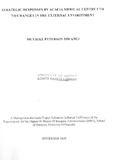| dc.description.abstract | An organization’s success is environment dependent. Organizations function within the
environment. The environment offers opportunities and posses threats to an organization depending
on the capabilities of an organization. For an organization to survive it has to pay keen attention to
its environment.
According to Ansoff (1984) organizations are open systems and they exist in the context of
turbulent environment. According to Pearce and Robinson (1997), in order for organizations to
achieve their goals and objectives it is necessary for them to adjust to their environment. An
organizations success is dependent on its responses to changes in the environment.
The environment can be classified into the internal and the external environments. The internal
environment is composed of elements within the organization; these include current employees,
management philosophy, managerial leadership styles, organization culture, financial resources,
technology, human resources, structures and processes. The internal environment is within the
control of the organization and is composed of controllable variables.
This study set out to address two objectives which were firstly to determine what changes in the
external environment has affected AMC, and secondly to determine what strategic responses the
company has employed to adapt the changes in the external environment.
To achieve these two objectives the study made use of both primary and secondary data. Primary
data was collected through personal interviews with senior management at AMC and with
management consultants of the company i.e. Quantum and Praxis. Secondary data was obtained
from AMC’s financial statement and in-house publications. A content analysis was then carried out
on the data obtained to allow for in-depth understanding of issues in the case.
The study found out that there was a formal strategic planning at AMC that was mostly done by
consultancy firms such as Miliki Care Ltd (Miliki), Quantum Africa Ltd (Quantum) and Praxis
Partners Ltd (Praxis).
The study found out that the company did not respond to all the changes in the environmental
conditions but to those changes which were deemed to impact on the company’s activities to a large extent. The study identified the following factors to have elicited responses from the company. In
the political environment the key variable had been the post election violence in 2008, in the legal
environment the key variable had been in taxation. In the technological environment the key
variable had been lack of IT support from dealers and high rate of obsolescence and new
technological developments. In the economic environment key variables had been low income
levels and high cost of factors of production. In the socio-cultural environment, key variables had
been lifestyle changes, income distribution, lobby groups, and safety needs as defined by Maslow’s
hierarchy of needs. In the competitive environment the key challenges had been from new entrants
in the industry and business undercutting.
The study recommended that AMC should expand to other East African countries to exploit the 100
million people market; further recommendations included vertical integration with suppliers,
adoption of financial controls and development of better corporate governance.
The study suggested that in order to understand the strategic responses possible for the changes at
AMC a further studies could be carried out in other companies within the HMO industry, a further
study could also be carried out to determine why AMC choose to use the responses it had adopted
and lastly a further suggested study could be carried out on AMC to determine how the company
would alter its strategies to other changes in the environment in future.
The study concluded that even for companies that were successful, it is comparative that they
continuously engage in strategic responses to ensure that the organization strategies are aligned and
match with external environment. | en_US |

